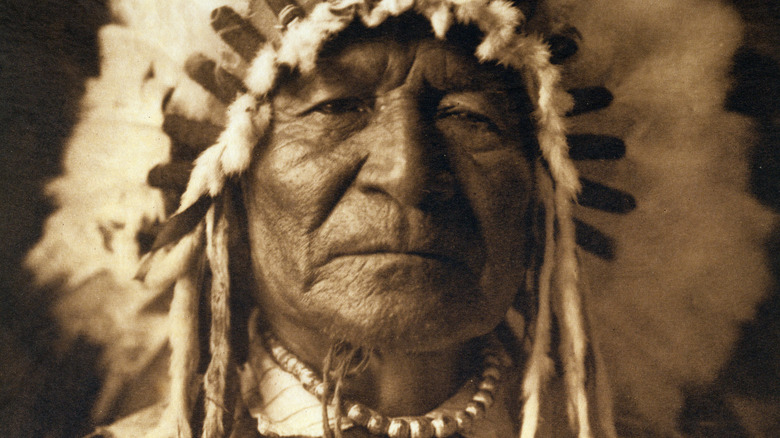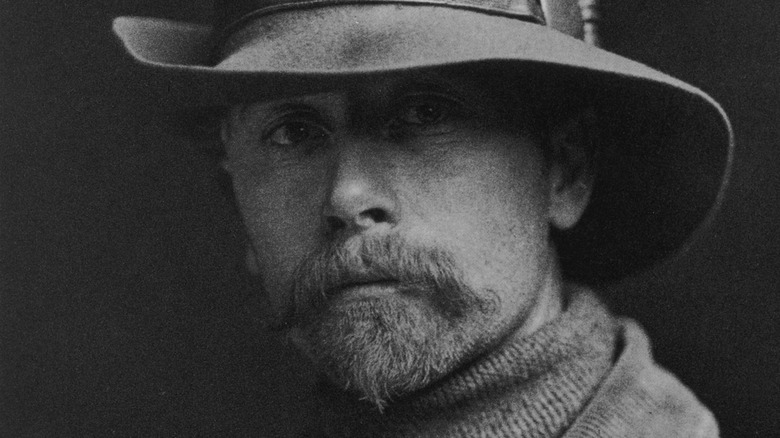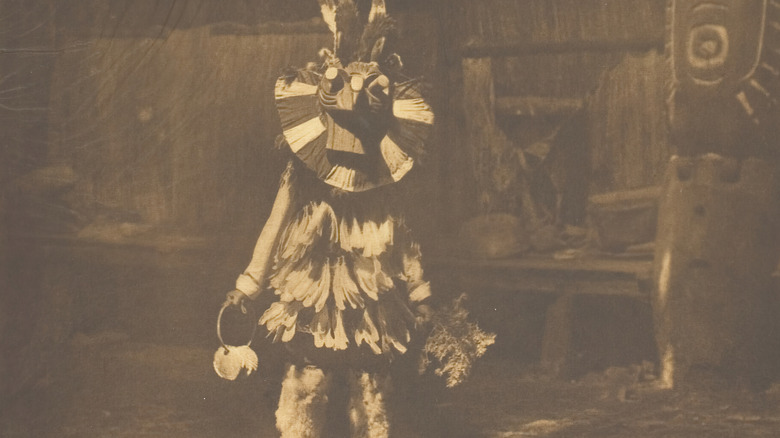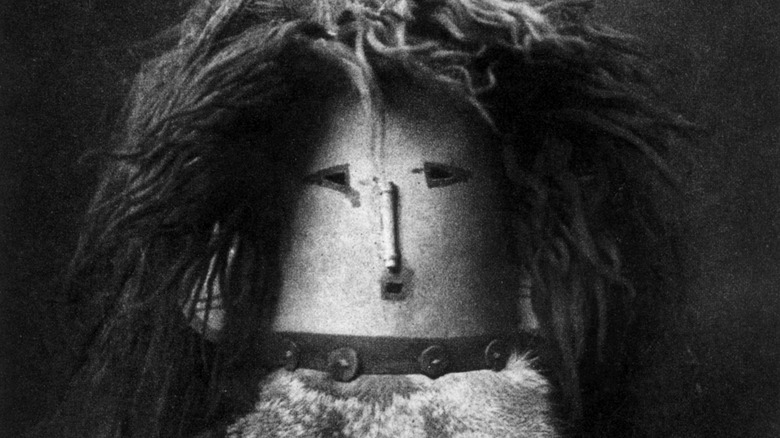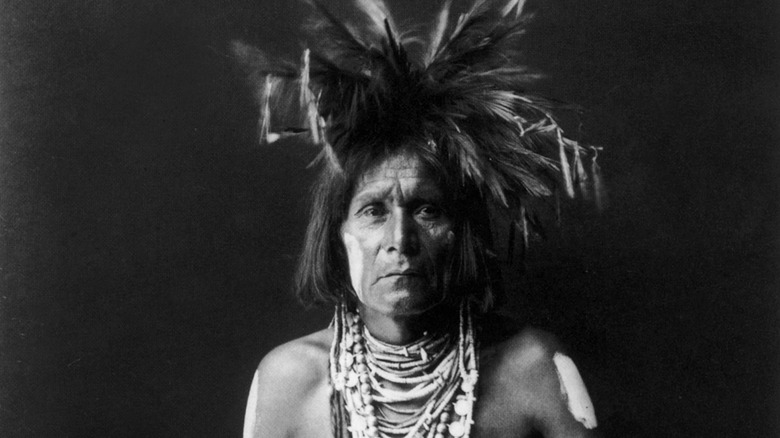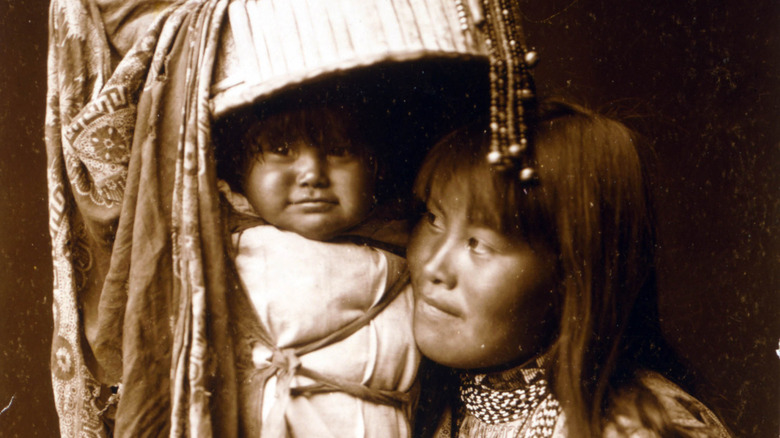The Only Memory Of Over 80 Native American Tribes Lives On In Edward S. Curtis' Photography
Fittingly nicknamed "shadow-catcher" by those he encountered, Edward S. Curtis captured the fleeting shadows of America's past, photographing the lifestyles of Native American people whose numbers were dwindling and whose way of life was quickly changing (via PBS). Born in 1868, he traveled across the U.S. and Canada in the early 20th century, taking photographs and making sound recordings of Native American tribes.
According to the U.S. government, there are still 574 officially recognized Native American tribes in the 48 contiguous states and Alaska today, but Native American culture has historically been under constant threat of extinction thanks to the confiscation of land and sacred objects, as well as reeducation programs (via The Library of Congress). Curtis helped record stories, songs, and histories, at a time when indigenous culture was not well-documented.
Theodore Roosevelt, a great admirer of the adventurous photographer, wrote the forward for Curtis' greatest work, "The North American Indian," stating that "... our generation offers the last chance for doing what Mr. Curtis has done. The (Native American) as he has hitherto been is on the point of passing away" (via Edward Curtis).
Who was Edward Curtis?
Curtis began his career as a photographer taking pictures of the well-heeled citizens of Seattle in the 1890s (via Smithsonian Magazine). In 1895 he took his first photo of a Native American person, a princess named Angeline from the Duwamish tribe. However, his real interest in Native American culture only began after Curtis joined two separate expeditions, to Alaska and Montana. His curiosity was ignited, and his plan to chronicle Native American life was conceived. In 1906, he secured $75,000 for the venture, thanks to banking magnate J.P. Morgan — a sum Curtis sorely needed, given the gigantic scale of the project.
Curtis' new obsession eclipsed all other aspects of his life, and he kept traveling despite a difficult divorce as well as bouts of illness. The results of his sometimes challenging journey, however, speak for themselves. Curtis produced 40,000 enchanting images, the best of which were turned into a 20-volume book series: "The North American Indian." Perhaps more important still, he put together hundreds of pages of detailed notes, which have provided future generations with an enormous wealth of information on the history, culture, and language of over 80 tribes (via PBS).
Voice and memory
In addition to taking photographs, Curtis made recordings of indigenous speech and songs using some fairly rudimentary recording equipment (via The Library of Congress). Those who can read sheet music will also find a treasure trove of tunes in Curtis' manuscript, which includes many pages of traditional songs — performance notes included. To give just one example, Volume 8 (via Northwestern University) includes some songs from the Wishram tribe, such as a canoeing song to be sung while paddling, and a "wooing" song to "make the girls feel lonesome."
Curtis also included extensive pronunciation guides for various native languages in his writings (via the University of Pittsburgh). His vocabulary lists give readers an introduction to commonly used words, such as the names of the months (via The North American Indian, Vol. 8, page 203). In regards to language, in particular, Curtis' contribution to history has been invaluable. One of the biggest cultural disasters for Native Americans has been widespread language loss. According to the Language Conservancy, 200 languages have gone extinct in the U.S. to date, and many others are likely to join them.
The wax cylinders Curtis used for recording were unfortunately rather fragile (via Edward Curtis). Although it is rumored that Curtis made 10,000 recordings, sadly, just 279 are in storage at the University of Indiana today (via Indiana University).
Religion and dance
Curtis was particularly fascinated by religion and dance. According to Smithsonian Magazine, his interest in Native American culture was partially sparked after he witnessed a Sun Dance ceremony, performed by the Piegan tribe. "The North American Indian" includes descriptions of many significant religious rituals, such as the Hopi snake dance (via the University of Pittsburgh) and various coming-of-age ceremonies.
Although Native American groups still perform religious dances, particularly sun dances (via Learn Religions), Native American religion was severely eroded in the 19th and early 20th centuries, when many children were forced to convert to Christianity (via The Library of Congress). Conversion erased many old religious practices from cultural memory, and some ceremonies became illegal in parts of the U.S. The Sun Dance itself was only legalized in 1970.
Curtis' work helped keep knowledge of Native American traditions alive, and some of his best and most beautiful photographs (via National Geographic) depict cultural costumes used in religious and mythological storytelling.
Mythology and history
Finally, a look through Curtis' work reveals a wealth of history and mythology — stories told to Curtis on his travels. Curtis initially had some trouble building trust with many of the tribes he encountered. He was attacked on several occasions and even had dirt thrown at him (via NPR). However, many people soon wished to speak to Curtis, agreeing to share their stories with him, sometimes due to a small financial incentive (via Smithsonian Magazine).
One 90-year-old Assiniboin man, for example, graciously agreed to tell Curtis about his tribe after refusing to talk to white settlers his entire life (via Edward Curtis). Known as Black Eagle, he related fascinating personal stories to Curtis, describing the battles he'd been in and the horses he had captured (via Curtis Legacy Foundation).
Odd cultural details are scattered throughout the books, such as a discussion of the historic migration of the Teton Sioux based on half-remembered details given by tribe members (via The North American Indian, Volume 3, pages 3-4). His books also contain many entertaining folk stories, including a collection of tales about the trickster character, Coyote (via The North American Indian, Volume 13, page 184).
Problems with Curtis' work
Although the value of Curtis' work is unquestionable, history enthusiasts should beware that academics have often raised concerns about fetishization and dramatic exaggeration in Curtis' photographs (via Études Photographiques, 2012). His work gives viewers the false impression that Native Americans lived totally apart from the modern world, trapped in a primitive bubble.
While this was intentional to an extent — an attempt to capture a disappearing way of life — it may at times mislead contemporary viewers, who often get the impression from Curtis' work that in the early 20th century, Native Americans were a world apart from white society. Curtis often staged his scenes, and according to National Geographic, this sometimes involved editing photographs to remove any evidence of the modern world, such as alarm clocks and other modern technologies.
Nevertheless, his effort to record Native American stories and faces should be celebrated. Interested readers can find a digitized version of the manuscript online at Northwestern University.
